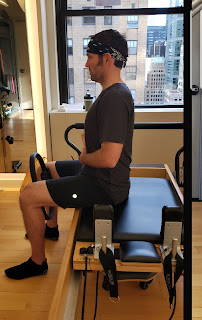What is Poor Posture? | Part 1
Posture | Part 1
by: Lisa Kocsis
One of the primary requests I receive from clients is to help them improve their posture. With the increase of technology and many of us working longer hours, a vast percentage of our population is spending a significant amount of time in a seated position, often in poor postural alignment. What exactly does this mean and how does it impact our lives? Due to the fact that there is an extensive amount of information regarding posture, I broke this blog into separate parts to make it easier to process.
Posture refers to the skeletal positioning we assume throughout the day, whether it be seated or standing. There are two types - static and dynamic. Static refers to a non-moving position, whereas dynamic refers to an active movement (e.g.walking, running or in an exercise). One of the greatest hurdles I encounter as an instructor is training my clients' posture. Over 90% of my client base has an office job and spends the majority of their day, often slouched, in front of their monitors. It's important to realize the negative impact this has on our overall health!
I want to emphasize how significant awareness is. The more time our body spends in a certain position, the more likely our skeletal structure will assume that posture as natural. As a result, the musculature adapts to the skeletal position we live in; in essence, the relationship of our bones to each other. An example... If we bend our trunk (spine) to the right, the muscles on that side will shorten and the muscles on the left side will lengthen. Now imagine being in this posture every day? Over the course of time, the muscles will "think" this is normal. The more time our musculature spends in a fixed position, the more challenging that postural positioning will be to correct. This is where coaching and training clients and yourself to work towards improving such becomes significant.
Listed here are a few issues that can be caused by poor posture...
Regarding our joint structures, excess load occurs when muscles are not properly supporting them. When we slouch we inhibit our spinal erectors, a primary support structure for our spine, from engaging. This can result in irregular wearing of joint surfaces and can lead to joint pain, dysfunction and arthritis. Improper function of our joint structures can also contribute to limited ROM. The less we move our joints to their full capacity, the more restricted these complexes will become over time.
Joints are not the only structures to be directly affected by postural positioning. Muscle tissue can become overactive or inhibited. Improper alignment of your skeletal structure can compound this problem. When you slouch, you shorten the anterior (front) aspect of your spine and trunk. This can cause compression of the vertebral discs and eventually result in possible degeneration of the structures, as well as bulging or herniated discs and sciatica. The musculature in your anterior trunk (abdominal wall, rectus abdominis [six-pack muscles] and external obliques), to name a few, becomes shortened due to the slouched position. The muscle tissue in the posterior (back) aspect of your trunk becomes elongated. The over lengthening of this musculature (spinal erectors, lats, mid-low trapezius, internal obliques) causes an increased inhibition of their ability to contract. This inhibition results in a decrease in tone and prevents the muscle tissue from being able to properly engage to support the joint structures of the spine. This contributes to many people's back pain, especially in their lower back and neck. This can compound the problem for those who suffer from headaches and migraines.
When we slouch, we inhibit our transverse abdominis (TVA/abdominal wall); this is our natural, internal weight belt muscle. Its job is to provide support to trunk structures...the rib cage, pelvis, shoulder girdle complex and viscera (internal organs). It's also supposed to assist with breathing and is engaged upon exhalation. Its ability to activate when needed is critically important to help support the spine, especially under load. Hence we now see the pertinence of proper posture and how it directly correlates to breathing and core activation. A weakened core, which is in part caused by poor posture, can have a negative impact on our balance and stability. We know our core affects our ability to stay stable, which becomes increasingly important as we age.
I dove into the topic of breathing, and some of the different breathing techniques, and how it relates to Pilates in my "What is Pilates" blog, so not going into too much detail about this here. However, I think it's important to address the point that your breathing can and will be inhibited as a result of poor postural positioning. When you slouch, there's a shortening that occurs in the front of the trunk. This collapsing of the structure causes compression on the diaphragm, our primary breathing muscle. When this happens, the diaphragm cannot properly function due to the excess load from the weight of the rib cage, shoulder girdle, internal organs and skull. These structures move out of their intended alignment when slouching occurs.






Comments
Post a Comment